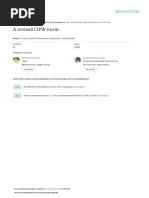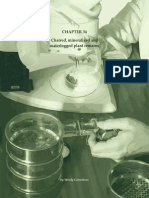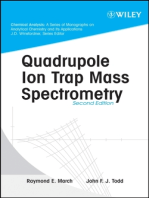Geology 435 Laboratory Exercise #3: Due Sept. 24
Geology 435 Laboratory Exercise #3: Due Sept. 24
Uploaded by
Ssewan JovialCopyright:
Available Formats
Geology 435 Laboratory Exercise #3: Due Sept. 24
Geology 435 Laboratory Exercise #3: Due Sept. 24
Uploaded by
Ssewan JovialOriginal Title
Copyright
Available Formats
Share this document
Did you find this document useful?
Is this content inappropriate?
Copyright:
Available Formats
Geology 435 Laboratory Exercise #3: Due Sept. 24
Geology 435 Laboratory Exercise #3: Due Sept. 24
Uploaded by
Ssewan JovialCopyright:
Available Formats
Geology 435 Laboratory Exercise #3:
Due Sept. 24
Non-Clastic Sediments and Rocks (Hand Samples, Binocular Microscope, and Hand Lens) References: Fichter and Poche, p57-63; Nichols, Ch3, p.25-36 Follow the instructions in your lab text starting on p. 60 for analysis of the following unconsolidated sediments (Part I) and the rock samples from cores (Part II). If they are not Carbonate Rocks/sediments; (i.e. orthochemical samples) bail out to the Chemical and Biochemical Rock Identification Key on p. 65. If they are carbonate sediments or rocks fill in Carbonate Data Sheets for each sample (p. 64). Some of the unconsolidated carbonate sediments are partially consolidated; you are looking at stuck-together (not lithified) sediment. There is no spar! You should also name each rock or unconsolidated sediment using the Dunham Classification scheme (see attached sheet) described and shown on p. 27-29 of Nichols. Also, apply a Folk Textural Classification name (see Fichter and Poche, p. 59) to samples for which this is useful and informative; describe why. I prefer the Dunham classification; you should be familiar with all of them. Another useful www site for Carbonate classification is:
http://www.sepmstrata.org/page.aspx?&pageid=89&4
I. Unconsolidated Carbonate sediments 1. Long Key, Florida Recent 2. Sugarloaf Key, Recent 3. Bimini Island, Bahamas, Recent BB-1 4. Florida Bay, Recent 5. Andros Platform, Bahamas, Recent
II.
Follow the instructions, as above, for at least seven samples from the core material available to you. You should choose as varied a selection of samples as possible from the cores that are available (at least one each of limestone, dolostone, evaporite, and chert.
You might also like
- MacgillavryRieckEds InternationalTablesForX RayCrystallographyVol3 TextDocument371 pagesMacgillavryRieckEds InternationalTablesForX RayCrystallographyVol3 TextLazar Alina100% (1)
- Structural Classification of Minerals - Vol 2 - Minerals With ApBqCrDs To ApBqCrDsExFyGz General Chemical Formulas - Lima-de-Faria (2003) PDFDocument162 pagesStructural Classification of Minerals - Vol 2 - Minerals With ApBqCrDs To ApBqCrDsExFyGz General Chemical Formulas - Lima-de-Faria (2003) PDFLuis Alonso SANo ratings yet
- Sandstone Thin Section StudyDocument7 pagesSandstone Thin Section StudyIjlal AhmadNo ratings yet
- Sequence StratigraphyFrom EverandSequence StratigraphyDominic EmeryNo ratings yet
- Cycles Student Aug10 09Document25 pagesCycles Student Aug10 09Lindsay CookNo ratings yet
- An Analysis of Debitage at Kosapsom Park Site (Dcru 4)Document18 pagesAn Analysis of Debitage at Kosapsom Park Site (Dcru 4)jayg76No ratings yet
- Metodos Recomendados para SuelosDocument716 pagesMetodos Recomendados para SuelosWilder Condori CastroNo ratings yet
- This Content Downloaded From 1.164.41.135 On Thu, 19 May 2022 04:40:07 UTCDocument15 pagesThis Content Downloaded From 1.164.41.135 On Thu, 19 May 2022 04:40:07 UTCWang JamesNo ratings yet
- AAS, X-RayDocument18 pagesAAS, X-Rayljubicica1965No ratings yet
- European Journal of Biochemistry - August 1969 - The Nomenclature of SteroidsDocument19 pagesEuropean Journal of Biochemistry - August 1969 - The Nomenclature of SteroidssanjeevmsivadasanNo ratings yet
- Chapter Nine: Physical Anthropology AnalysisDocument67 pagesChapter Nine: Physical Anthropology AnalysistrutiNo ratings yet
- US8343403Document8 pagesUS8343403Adrià Chavanel I SaltóNo ratings yet
- 04 Plouffe EtalDocument8 pages04 Plouffe EtalArif RahmatNo ratings yet
- Biochemj01004 0093 PDFDocument8 pagesBiochemj01004 0093 PDFAni Yunita SariNo ratings yet
- Comparison of Soil Sample Homogenization TechniqueDocument49 pagesComparison of Soil Sample Homogenization TechniqueAhmad AliNo ratings yet
- RF ValueDocument2 pagesRF ValueLiixyz LingNo ratings yet
- Quantitative Sampling of Soft-Bottom Sediments: Problems and SolutionsDocument10 pagesQuantitative Sampling of Soft-Bottom Sediments: Problems and Solutionsjose razoNo ratings yet
- Rickwood1989 PDFDocument17 pagesRickwood1989 PDFAaron mNo ratings yet
- 364 Exam Sample QuestionsDocument1 page364 Exam Sample QuestionsFachmy Muhammad IrhamsyahNo ratings yet
- A Revised CIPW NormDocument21 pagesA Revised CIPW NormSebastianLopezNo ratings yet
- Hogarth 1977 - Classificatio Pyrochlore GroupDocument8 pagesHogarth 1977 - Classificatio Pyrochlore GroupIngrid Weber HadlichNo ratings yet
- Brazilian Tensile Strength of Anisotropic RocksDocument25 pagesBrazilian Tensile Strength of Anisotropic RocksAli FahemNo ratings yet
- CCMN 1982 0300113Document1 pageCCMN 1982 0300113FOUTOUNo ratings yet
- Earth Science-Grade 11: I. Introductory ConceptDocument13 pagesEarth Science-Grade 11: I. Introductory ConceptMaxine ReyesNo ratings yet
- Backman Et Al., 2012, Biozonation and Biochronology of Miocene - NannofosilDocument24 pagesBackman Et Al., 2012, Biozonation and Biochronology of Miocene - NannofosilJabatio PrimizakariaNo ratings yet
- BartonN 2022 Keynotelecture LARMS2022Document27 pagesBartonN 2022 Keynotelecture LARMS2022Sajjad AnwarNo ratings yet
- Igneous Rocks - A Classification and Glossary of TermsDocument254 pagesIgneous Rocks - A Classification and Glossary of Termsregulus7100% (17)
- Glossário ÍgneasDocument254 pagesGlossário ÍgneasfilippeofNo ratings yet
- Historic Mortars: Characteristics and Tests - Concluding Summary and State-Of-The-ArtDocument12 pagesHistoric Mortars: Characteristics and Tests - Concluding Summary and State-Of-The-Artmiss meeraNo ratings yet
- ROGERS Subsurface Exploration Using The Standard PenetrationDocument6 pagesROGERS Subsurface Exploration Using The Standard PenetrationFrimini Mng'anyaNo ratings yet
- Mala Identificacion de Talleres LiticosDocument16 pagesMala Identificacion de Talleres LiticosjesusNo ratings yet
- Excavations at Stansted Airport: Charred PlantsDocument50 pagesExcavations at Stansted Airport: Charred PlantsFramework Archaeology100% (1)
- Nomn of Steroid2Document19 pagesNomn of Steroid2abh_sah2No ratings yet
- International Society For Rock Mechanics Commission On Standardization of Laboratory and Field TestsDocument3 pagesInternational Society For Rock Mechanics Commission On Standardization of Laboratory and Field TestsJimmy AngelNo ratings yet
- GEOL 4320/6320 Questions For Exams I and IIDocument4 pagesGEOL 4320/6320 Questions For Exams I and IIHollowAnggara100% (1)
- The American Mineralogist, Vol.56, September October, 1971Document15 pagesThe American Mineralogist, Vol.56, September October, 1971Indra Gugun GunawanNo ratings yet
- What Is Core Logging?: The Following Steps Are Suggested During The Core Logging ProcessDocument4 pagesWhat Is Core Logging?: The Following Steps Are Suggested During The Core Logging ProcessMacKenzie VivetNo ratings yet
- Gatoplano - Historia y MetodoDocument12 pagesGatoplano - Historia y MetodoantonioNo ratings yet
- Sepmstrata Org Caco3 Petrology HTMLDocument3 pagesSepmstrata Org Caco3 Petrology HTMLAtif AbassNo ratings yet
- Estudo Sobre Estrutura, Ciclo de Vida e Comportamendo de S. BrasiliensisDocument20 pagesEstudo Sobre Estrutura, Ciclo de Vida e Comportamendo de S. BrasiliensisMilton JuniorNo ratings yet
- Catalog of Apollo 16 RocksDocument1,181 pagesCatalog of Apollo 16 RocksBob AndrepontNo ratings yet
- Tensile Fracturing in Rocks (D. Bahat, A. Rabinovitch & V. Frid 2005) PDFDocument579 pagesTensile Fracturing in Rocks (D. Bahat, A. Rabinovitch & V. Frid 2005) PDFFabian MartinezNo ratings yet
- Hydrothermal Breccias in Vein-Type Ore D PDFDocument24 pagesHydrothermal Breccias in Vein-Type Ore D PDFRicardo CesarNo ratings yet
- Heterocyclic Systems with Bridgehead Nitrogen Atoms, Part 1From EverandHeterocyclic Systems with Bridgehead Nitrogen Atoms, Part 1William L. MosbyNo ratings yet
- Experimentation and Interpretation: the Use of Experimental Archaeology in the Study of the PastFrom EverandExperimentation and Interpretation: the Use of Experimental Archaeology in the Study of the PastNo ratings yet
- Sedimentary Rocks in the Field: A Practical GuideFrom EverandSedimentary Rocks in the Field: A Practical GuideRating: 4 out of 5 stars4/5 (4)
- Heterocyclic Derivatives of Phosphorous, Arsenic, Antimony and BismuthFrom EverandHeterocyclic Derivatives of Phosphorous, Arsenic, Antimony and BismuthNo ratings yet
- Lithic Technologies in Sedentary SocietiesFrom EverandLithic Technologies in Sedentary SocietiesRachel A. HorowitzNo ratings yet
- Sedimentary Petrology: An Introduction to the Origin of Sedimentary RocksFrom EverandSedimentary Petrology: An Introduction to the Origin of Sedimentary RocksRating: 4.5 out of 5 stars4.5/5 (3)
- The 1,2,3- and 1,2,4-Triazines, Tetrazines and PentazinesFrom EverandThe 1,2,3- and 1,2,4-Triazines, Tetrazines and PentazinesJohn G. EricksonNo ratings yet
- Designing Experimental Research in Archaeology: Examining Technology through Production and UseFrom EverandDesigning Experimental Research in Archaeology: Examining Technology through Production and UseNo ratings yet
- Fundamentals of the Petrophysics of Oil and Gas ReservoirsFrom EverandFundamentals of the Petrophysics of Oil and Gas ReservoirsNo ratings yet
- Multi-Sulfur and Sulfur and Oxygen Five- and Six-Membered Heterocycles, Part 1From EverandMulti-Sulfur and Sulfur and Oxygen Five- and Six-Membered Heterocycles, Part 1David S. BreslowNo ratings yet
- APPEL A Candidature Archipelago 2020Document6 pagesAPPEL A Candidature Archipelago 2020Ssewan JovialNo ratings yet
- Recommandation S 2Document8 pagesRecommandation S 2Ssewan JovialNo ratings yet
- Epfl TH5356Document266 pagesEpfl TH5356Ssewan JovialNo ratings yet
- 3 - RioualD - Pumped Storage Hydropower Status PDFDocument21 pages3 - RioualD - Pumped Storage Hydropower Status PDFSsewan Jovial100% (1)
- Utilisation (Economics, Policy, Supplies, Forecasts)Document1 pageUtilisation (Economics, Policy, Supplies, Forecasts)Ssewan JovialNo ratings yet
- Ex 4 Sedrox 1 Rockcyn PDFDocument5 pagesEx 4 Sedrox 1 Rockcyn PDFSsewan JovialNo ratings yet

































































